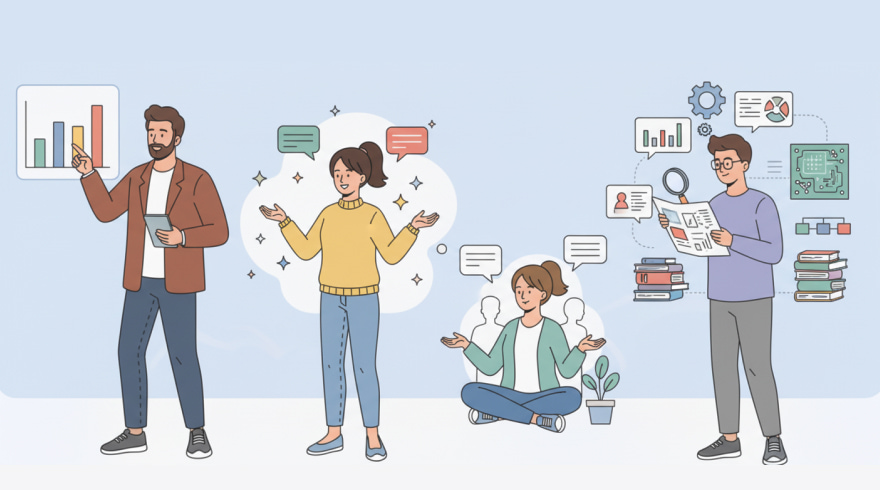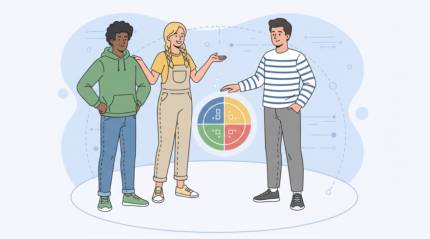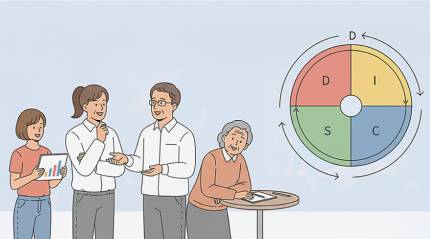A Complete Guide to the DISC Framework: Insights, Benefits, and Practical Use
- 11 October 2025

The DISC framework is a pragmatic lens for understanding how people prefer to act, interact, and make decisions. Rooted in behavioral science, it clusters day-to-day tendencies into four familiar styles that are easy to recognize under pressure and in calm conditions alike. Leaders value it because the framework is simple to teach yet nuanced enough to inform coaching, hiring, sales enablement, and conflict resolution. Individuals appreciate it for the immediate self-awareness and language it brings to difficult conversations, especially around pace, priorities, and collaboration habits.
Rather than guessing at teammates’ intentions, teams benefit from a shared vocabulary that de-personalizes friction and highlights complementary strengths. In practice, professionals often start with the DISC test to benchmark their baseline and open a shared language for behavior. That baseline then becomes a compass for tasks like planning meetings, designing roles, and pairing mentors with mentees.
Because velocity and ambiguity are the new normal, organizations need tools that surface behavioral patterns quickly and responsibly. When organizations need a quick pulse check across departments, the DISC model test supplies a standardized snapshot without complex setup. Over time, the insights compound: managers reduce rework, projects align to natural strengths, and communication friction drops because expectations are explicit instead of implied.
- Clear vocabulary: replaces assumptions with observable patterns.
- Fast adoption: simple categories, memorable language.
- Actionable results: insights translate into scheduling, staffing, and feedback routines.
- Scalable process: useful for individuals, intact teams, and entire business units.
How the Four Styles Work: From Traits to Real-World Signals
DISC organizes behavioral preferences into four styles often described as task vs. people focus and fast vs. steady pace. While everyone exhibits a blend, most people show a dominant tendency that becomes especially visible under deadlines or stakeholder pressure. Observers can spot these preferences in verbal tone, body language, risk appetite, and the way someone frames decisions and trade-offs. This makes the framework pragmatic for sales, service, product, and operations alike.
To capture that nuance across changing contexts, the DISC profile test gives richer granularity than a one-off quiz. Trend lines and situational contrasts reveal how someone may flex at work versus at home, or during calm retrospectives versus urgent incidents, providing sharper coaching targets.
Cost should not be a barrier to literacy in behavioral dynamics, and thoughtful practitioners curate resources that balance accessibility with quality. Budget-conscious learners appreciate that the DISC personality test free options can still introduce reliable constructs when chosen carefully. With proper facilitation, even simple instruments help people name blind spots, negotiate preferences, and co-create team norms that stand up to stress.
- D: direct, decisive, and energized by challenges and rapid outcomes.
- I: expressive, persuasive, and motivated by social energy and recognition.
- S: steady, supportive, and anchored in reliability and team harmony.
- C: analytical, quality-driven, and focused on accuracy and risk reduction.
Benefits and Use Cases: From Self-Insight to Strategy Execution
High-performing organizations translate human insight into repeatable practices. DISC helps managers tailor feedback, align responsibilities to natural strengths, and reduce churn by clarifying expectations early. When onboarding ramps up, the framework shortens time-to-value because new teammates quickly understand how to approach colleagues, when to escalate, and how to negotiate responsibilities while maintaining psychological safety.
Before a leadership program begins, the DISC assessment test helps facilitators map coaching tracks to real behavioral evidence. Cohorts can then practice techniques that fit their style, such as structured briefings for analytical teammates or time-boxed brainstorming for highly expressive colleagues.
Experimentation is easier when tooling costs are minimal and the stakes are clear. Small teams piloting new tools sometimes select a DISC assessment test free version to validate fit before wider rollout. After confirming value, they typically layer in richer reporting, longitudinal tracking, and integration with performance conversations to scale impact without losing nuance.
- Sharper collaboration: fewer misunderstandings and faster decisions.
- Better role design: tasks map to strengths, reducing fatigue and rework.
- Improved coaching: concrete behaviors replace vague personality labels.
- Consistent hiring: structured interviews probe for situational behavior, not buzzwords.
Going Digital: Taking DISC Remotely and Preparing for Best Results
Distributed work demands tools that are accessible, fast, and reliable across devices. Digital delivery ensures that individuals can complete questionnaires at convenient times, and it lets facilitators aggregate results instantly. Preparation still matters: a quiet setting, honest reflection, and a focus on typical behavior rather than aspirational ideals produce cleaner data and more trustworthy insights.
Remote teams appreciate how a DISC test online format reduces friction and speeds up onboarding. Clear instructions, time estimates, and practice items help first-time takers reduce anxiety and avoid overthinking choices during the process.
During hackathons or bootcamps, a DISC test online free pathway accelerates participation without procurement delays. Organizers can then host debriefs in breakout rooms, pairing complementary styles to simulate real project dynamics while modeling psychological safety and constructive feedback.
- Set expectations: explain purpose, confidentiality, and how results will be used.
- Encourage candor: emphasize typical behavior, not “ideal employee” answers.
- Plan debriefs: allocate time to interpret results and translate into actions.
- Follow up: revisit insights after milestones to reinforce learning.
Interpreting Results: From Reports to Real Behavior
Reports are only as valuable as the conversations they unlock. Effective facilitators translate graphs into concrete agreements: meeting norms, feedback cadences, and conflict protocols. They help teams apply insights to planning, prioritization, and stakeholder management, so the learning lives beyond a single workshop. Visual summaries, story-driven debriefs, and role-play scenarios make the insights sticky and actionable.
| Style | Core Drives | Strengths | Watch-outs | Coaching Moves |
|---|---|---|---|---|
| D | Results, autonomy | Decisive, bold | Impatience, bluntness | Align on outcomes, set check-ins |
| I | Social impact, visibility | Inspiring, connective | Overcommitting, distraction | Time-box ideation, clarify owners |
| S | Stability, support | Reliable, empathetic | Conflict avoidance, slow change | Stage changes, invite voice early |
| C | Accuracy, logic | Thorough, quality-focused | Analysis paralysis, rigidity | Define criteria, agree on “good enough” |
For students exploring majors, a DISC profile test free alternative can spark reflection ahead of internships. Career centers sometimes curate a DISC personality types test free link alongside resume resources to widen access. After the initial read, individuals should journal recent situations, highlight effective behaviors, and identify one habit to start, one to stop, and one to continue based on the evidence.
Implementation Tips, Ethics, and Common Pitfalls
Ethical use is non-negotiable: tools should inform decisions, not pigeonhole people or excuse poor behavior. Practitioners must avoid labeling individuals as fixed types and instead emphasize adaptability and context. Facilitation should underscore strengths, potential derailers, and mutually agreed experiments that can be observed and refined over time. Measurement then becomes a loop of practice, feedback, and adjustment rather than a one-time label.
If you are simply experimenting, you can start with a DISC test for free and later upgrade to enterprise-grade analytics. That pathway respects budgets while enabling teams to pilot debriefs, document norms, and gauge cultural fit before scaling.
Educators running flipped classrooms may assign a DISC profile test free online before group projects to streamline role selection. Instructors can then coach teams to draft working agreements that include communication channels, decision rules, and conflict protocols aligned with the mix of styles present.
- Avoid stereotyping: describe behaviors, not identities.
- Contextualize: DISCuss how stress or stakes shift tendencies.
- Operationalize: turn insights into explicit team practices.
- Revisit: schedule retros to test whether agreements are working.
FAQ: Common Questions About the DISC Approach
- Is DISC a personality theory or a behavioral tool?
DISC is best treated as a behavioral tool that describes observable preferences rather than a deep personality taxonomy. It focuses on how people tend to act and communicate, especially under varying levels of pressure, making it actionable for day-to-day work.
- How accurate are results over time?
Results are generally stable for typical contexts, but shifts in role, stress, or environment can nudge behaviors. Retesting during major transitions and keeping a reflective journal helps track productive adaptations and reduce unhelpful drift.
- Can DISC improve team performance quickly?
Yes, when insights are turned into concrete agreements. Teams see faster decisions, clearer handoffs, and fewer misunderstandings when they codify meeting norms, escalation paths, and feedback rituals informed by the styles present.
- Should DISC be used in hiring decisions?
It can inform structured interviews and onboarding plans, but it should never be the sole hiring criterion. Ethical use emphasizes fairness, job-relevant behaviors, and transparency about how information will be applied.
- What makes a great debrief after taking DISC?
Effective debriefs are psychologically safe, evidence-based, and action-oriented. Facilitators translate charts into behaviors, co-create experiments, and set review dates so insights compound into durable habits and measurable outcomes.



